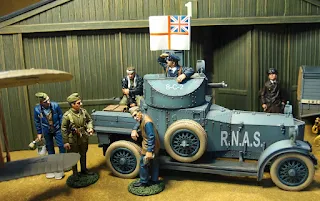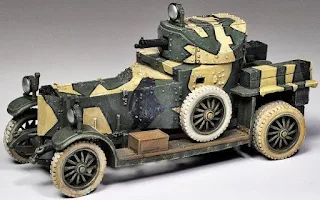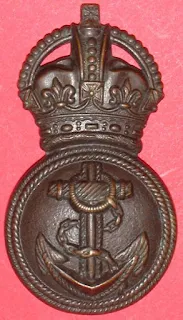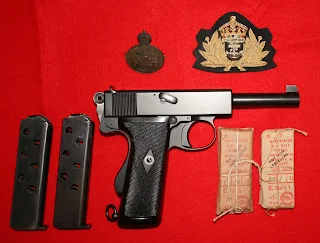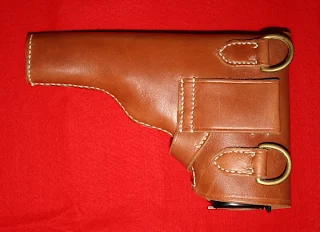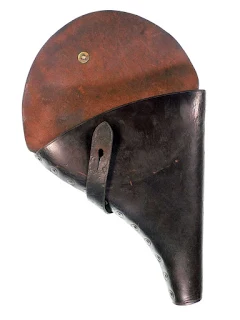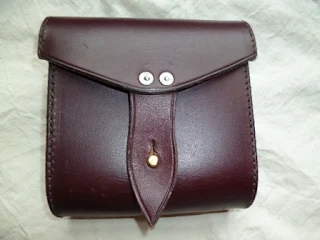The RNAS Armoured Car Squadron collar devices offer
a convenient Segway into that unique organization, who’s concept and
achievements provided the origins of the initial mission and engagements of the
Special Air Service, as well as those of Long Range Desert Group, and No. 1
Demolition Squadron (Popski’s Private Army) during World War II. Cdr Charles R.
Samson (later Air Commodore Charles Rumney Samson CMG, DSO & Bar, AFC) like
his contemporary Col. Thomas Edward “T. E.” Lawrence CB DSO FAS (“Laurence of
Arabia”), was a military visionary, and a predecessor of LtCoL David Stirling (later
Sir Archibald David Stirling DSO OBE), famous founder of the Special Air Service Regiment, by a
generation.
With full acknowledgement and expressed gratitude to the YOONIQ Images web site the following is a very early contemporary photograph of the Cdr C.R. Samson and immediate staff of the RNAS Armoured Car Squadron. It was probably taken circa early Fall 1914, with the cobble stone street of Antwerp or Liege, Belgium. As a a British naval aviation pioneer he was one of the first four officers selected for pilot training by the Royal Navy and was the first person person to fly an aircraft off a moving ship. Of particular interest is the presence of the two Royal Naval Reserve lieutenants and the Royal Marine officer. Given the specific configuration of the one officer's ammunition pouch and riveted holster, it's highly probable that he is carrying a .455cal. Webley Pistol, Self-Loading Model 1912, Mk IN. This is also the case for Cdr Samson, given his pistol holster's configuration. For those who may be interested in more detail scroll down on; http://arnhemjim.blogspot.com/2016/05/tell-it-to-marines.html . The other RNR lieutenant with the monocle, judging by the lanyard, is also carrying either a revolver or pistol which cannot be further identified by the author (Almost looks like he may be holding a pipe, or is that a very large lanyard ring.)
With full acknowledgement and expressed gratitude to the YOONIQ Images web site the following is a very early contemporary photograph of the Cdr C.R. Samson and immediate staff of the RNAS Armoured Car Squadron. It was probably taken circa early Fall 1914, with the cobble stone street of Antwerp or Liege, Belgium. As a a British naval aviation pioneer he was one of the first four officers selected for pilot training by the Royal Navy and was the first person person to fly an aircraft off a moving ship. Of particular interest is the presence of the two Royal Naval Reserve lieutenants and the Royal Marine officer. Given the specific configuration of the one officer's ammunition pouch and riveted holster, it's highly probable that he is carrying a .455cal. Webley Pistol, Self-Loading Model 1912, Mk IN. This is also the case for Cdr Samson, given his pistol holster's configuration. For those who may be interested in more detail scroll down on; http://arnhemjim.blogspot.com/2016/05/tell-it-to-marines.html . The other RNR lieutenant with the monocle, judging by the lanyard, is also carrying either a revolver or pistol which cannot be further identified by the author (Almost looks like he may be holding a pipe, or is that a very large lanyard ring.)
Without
going into excruciating, potentially boring detail, the following is a summary
of the organization of the Royal Navy’s armoured cars during World War I. From an extremely modest
beginning of a single squadron the order-of-battle quickly expanded, and the
unit was finally officially designated the Royal Naval Armoured Car Division
(RNACD). 4 cars comprised a Section. Three Sections comprised a Squadron, and
eventually 15 then 20 Squadrons constituted the Division. This would indicate an order-of-battle of 240 vehicles. Records show 120 Rolls Royce cars being built during World War I. These cars constituted half the Division. The balance was comprised of a combination of Worseley and Clement-Talbots armoured cars.
In anticipation of the probable immediate reader's question, what did these other cars look like? Here are photographs of first, one of the Worseley cars, and then one of the Clement-Talbot cars. Both photographs are of the actual original vehicles in Cdr Samson's initial squadron, taken in early Fall 1914. The one of the Talbot contained in the railroad magazine page, while not of the best resolution, is considered by experts to be extremely rare.
The internet is replete with narratives and imagery of the
RNAS Armoured Car Squadrons (later Division), so it is not intended to repeat that
information here. For the inclined reader three excellent initial sources are; https://en.wikipedia.org/wiki/Rolls-Royce_Armoured_Car , https://en.wikipedia.org/wiki/Royal_Naval_Air_Service and http://www.oocities.org/pentagon/base/1545/WWI/Main/ArmouredCars/RNArmouredCars.htm . Rather, this article will try to reiterate one
of the principal themes of this blog; illustrating how history can be reflected
in the art of the toy soldier and military miniature by selected examples, and
studied from that perspective.
Although a post World War I configuration Model 1920 Mk I, here is a photograph of a finely restored Rolls Royce Armoured Car currently residing at the Bovington Museum.
The basic specifications of the Rolls Royce Armoured Car are as follows:
Manufacturer Rolls Royce
Although a post World War I configuration Model 1920 Mk I, here is a photograph of a finely restored Rolls Royce Armoured Car currently residing at the Bovington Museum.
The basic specifications of the Rolls Royce Armoured Car are as follows:
Manufacturer Rolls Royce
Number built 120 During World War I
Variants Rolls Royce 1920 Pattern
Rolls Royce 1924 Pattern
Fordson Armored Car, Rolls
Royce Indian Pattern
Weight 4.7 tonnes
Length 4.93 m (194 in)
Width 1.93 m (76 in)
Height 2.54 m (100 in)
Crew 3
Armor 12 mm (0.47 in)
Main .303cal. Vickers Medium
armament Machine Gun
Secondary None
armament
Engine 6-cylinder petro, water-cooled
Power/weight 80 hp (60 kW)
19 hp/tonne
Suspension 4X2 wheel (double rear wheels),
Leaf spring
Operational 240 km (150 miles)
range
Speed (max.) 72 km/hr (45 mph)
The armoured car incorporated into the design of the collar
device represents the highly modified Rolls Royce Silver Ghost, with the first
three vehicles being delivered on 3 December 1914. They replaced their
predecessors, also Rolls Royces, which had been hurriedly improvised under Cdr
Samson’s direction during the earliest days of World War I.
Both designs, as well as follow-on configurations have long
been popular subjects of scale military model enthusiasts, as well as toy
soldier and military miniature manufacturers. Among others the iconic British
firm Wm. Britains Ltd. produced the Armoured Car, with swiveling gun, Set 1321, which was introduced in 1933 and produced until 1941. However, it represented a model of a hybrid Crossley/Rolls armoured car, not a pure Rolls. It was not until 1997, in a design by
Charles Briggs, and a brief resurgence of cast alloy Britains, that the Royal
Naval Armoured Car, 1914, Set 8925, made a brief appearance in 1:32 scale (same as Wm. Britains toy soldiers), in its Premier
Series. It has long since been retired, now being sought on the internet and at
auctions by collectors, particularly during the recent centennial of World War
I. The following photographs chronicle a rare image of the original Rolls Amoured car, along with Charles Briggs and W. Britains Ltd, miniature reincarnation.
The purpose built Rolls Royce Armoured Car soldiered on at the conclusion of hostilities in 1918, serving in as divergent locations as Siberia to Ireland, India and Iraq during the inter-war years, and even on into the early period of World War II. It underwent significant modifications in the 1920 and 1924 models. The first photograph is of a beautifully restored (truly unbelievable), currently fully operational vehicle.
However, for those of us who may be slightly less affluent, one of many alternatives exist. John Jenkins, another manufacturer of military miniatures, makes a 1:30 scale model of one of Cdr Samson's armored cars, issued as set De JJ-BGC-03, in the original accurate livery:
Thomas Gunn, still another military miniature maker, offers a slightly different color scheme, again in 1:30 scale, as set GW016B:
The firm King and Country brings the same car into World War II in the configuration employed by the British 1st Army in North Africa in 1940. The model, set EA044 was introduced in 2011, also in 1:30 scale, it has been retired, and is now sought after by collectors.
For those readers who might be interested, the following is a video of the Rolls Royce Armoured Car, Mk I, Model 1920, showing it in service with two long term protagonists, Great Britain and the Irish Free State;













